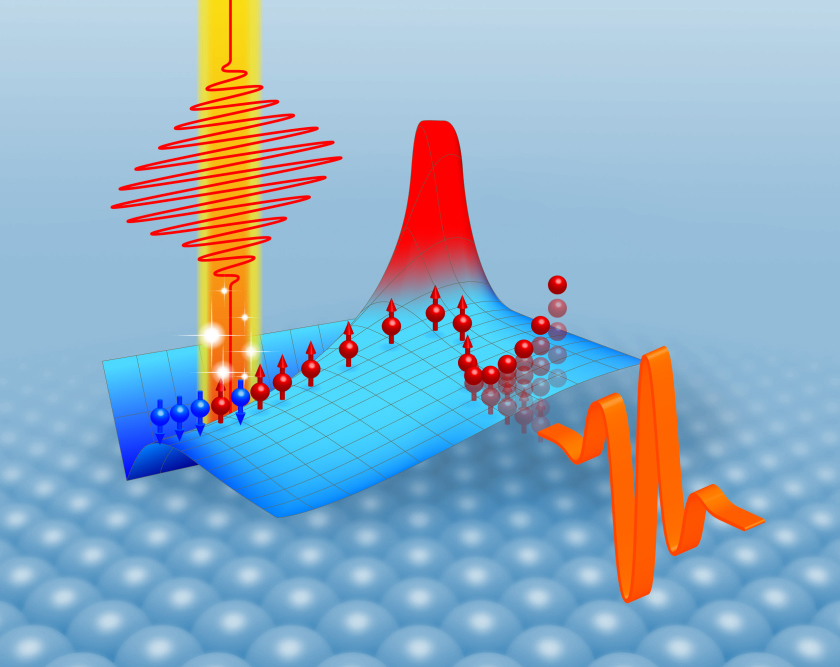Ultrafast Spin Manipulation at THz frequencies

An ultrafast spin current triggers the emission of Terahertz-Radiation. © H. D. Wöhrle/Universität Göttingen
The demands for ever increasing speed of information storage and data processing have triggered an intense search for finding the ultimately fast ways to manipulate spins in a magnetic medium. In this context, the use of femtosecond light pulses – the fastest man-made event - with photon energies ranging from X-rays (as used for instance at the HZB femto-slicing facility) to THz spectral range proved to be an indispensable tool in ultrafast spin and magnetization dynamics studies.
In a paper in Nature Nanotechnology, HZB-scientist Ilie Radu and his colleagues from Fritz-Haber-Institut Berlin, Uppsala, Göttingen and Forschungzentrum Jülich demonstrate a simple but very powerful way of manipulating the spins at unprecedented speeds within the so far unexplored THz range (1THz=1012 Hz). They use a femtosecond laser pulse to photo-excite the spins from a magnetic material to a non-magnetic one that is chosen to either trap or release the electrons carrying the spins. By this method they are able to generate ultrashort spin currents with tailor-made shapes and durations, which are detected using an ‘ultrafast amperemeter’ (based on the Inverse Spin Hall Effect) that converts the spin flow into a terahertz electromagnetic pulse.
These findings will possibly allow us to develop and design novel material with tailor-made characteristics, which might boost the magnetic recording rates of the magnetic bits to unprecedented speeds at THz frequencies.
I.R.
The work is published in:T. Kampfrath et al. „Terahertz spin current pulses controlled by magnetic heterostructures”, Nature Nanotechnology 2013, doi: http://dx.doi.org/10.1038/NNANO.2013.43.
https://www.helmholtz-berlin.de/pubbin/news_seite?nid=13688;sprache=en
- Copy link
-
Ernst Eckhard Koch Prize and Innovation Award on Synchrotron Radiation 2025
At the 27th BESSY@HZB User Meeting, the Friends of HZB honoured the dissertation of Dr Enggar Pramanto Wibowo (Friedrich-Alexander University Erlangen-Nuremberg). The Innovation Award on Synchrotron Radiation 2025 went to Prof. Tim Salditt (Georg-August-University Göttingen) and Professors Danny D. Jonigk and Maximilian Ackermann (both, University Hospital of RWTH Aachen University).
-
Synchrotron radiation sources: toolboxes for quantum technologies
Synchrotron radiation sources generate highly brilliant light pulses, ranging from infrared to hard X-rays, which can be used to gain deep insights into complex materials. An international team has now published an overview on synchrotron methods for the further development of quantum materials and technologies in the journal Advanced Functional Materials: Using concrete examples, they show how these unique tools can help to unlock the potential of quantum technologies such as quantum computing, overcome production barriers and pave the way for future breakthroughs.
-
Peat as a sustainable precursor for fuel cell catalyst materials
Iron-nitrogen-carbon catalysts have the potential to replace the more expensive platinum catalysts currently used in fuel cells. This is shown by a study conducted by researchers from the Helmholtz-Zentrum Berlin (HZB), Physikalisch-Technische Bundesanstalt (PTB) and universities in Tartu and Tallinn, Estonia. At BESSY II, the team observed the formation of complex microstructures within various samples. They then analysed which structural parameters were particularly important for fostering the preferred electrochemical reactions. The raw material for such catalysts is well decomposed peat.
